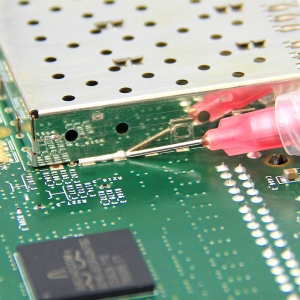6 Things to consider when selecting electrically conductive Adhesive
There are many ways to improve the electrical continuity of electronic enclosures and the resultant EMC performance using a variety of electrically conductive gaskets and mechanical fasteners. Such arrangements have the advantage of being clean and easy to use as well as allowing for the equipment to be disassembled and the components replaced. So, ask the question: Is a compound the right solution in this particular case?
Finding the right electrically conductive compound
Assuming you have eliminated the use of EMI shielding gaskets and mechanical fixings as being appropriate or possible for your design, the next step is to choose the most suitable electrically conductive compound for your application. These typical properties should be considered in order of importance as part of the selection process:
- Binder or base resin system (silicone, epoxy etc.)
- Electrically conductive filler type (carbon, silver, etc.)
- Single part or two-part
- Compound type (adhesive, caulk, sealant)
- Consistency (thick pastes to nearly liquid)
- Lap shear strength
- DC resistivity
- Use temperature range
- Cure temperature and time
- Working life
- Shelf life
- Coverage
- Recommended thickness
- Coefficient of thermal expansion
- Galvanic potential
- Surface preparation
This list above does not cover all the properties of the material that may be of interest to the engineer. In each application, the engineer needs to assess the requirements of the design problem to see how well the material properties match up to the most critical parameters.
- Surface preparation Having chosen your compound carefully, make sure to read the data sheet and any information relating to the surface preparation. All vendors generally either give information on the product datasheet or like Parker Chomerics on a separate surface preparation application note.Failure to prepare the surface properly will result in either a poor quality joint or one that fails prematurely, if not immediately. Preparation can be as simple as wiping down with isopropyl alcohol or involve more complex procedures such as a corona discharge treatment, etching or sandblasting and the use of primers.
- Correct compound type Conductive compounds are classed as adhesives, caulks and sealants. Typically, you will find that electrically conductive adhesives have finer conductive particles and have maximum bondline thicknesses, while electrically conductive sealants or caulks have larger particles and have minimum bondline thicknesses.Therefore, choosing a sealant and trying to use it as an adhesive with a thinner bondline than specified may result in unexpected results such as crushing of the conductive particles, damage to the mating surfaces, or unsatisfactory bond strength.
- Curing the compound Conductive epoxies have the option of curing at elevated temperatures but normally this may be limited by the material of the window or the housing if it is not metal. Some two-part silicones also have the option, whereas the most commonly encountered one-part RTV silicones do not.Normally if cured at room temperature silicone materials take 24 hours before being suitable for handling, and seven days before they are fully cured. This also depends on the level of moisture on the surfaces and in the air being adequate. In low humidity conditions or where the bondline is thick, the cure times may need to be extended.
- Galvanic potential This is especially important if the joint is to be exposed to harsh or marine environments. In such situations, the joint should be galvanically matched to the substrate as closely as possible (within 0.25v) and if necessary, a secondary protective non-conductive caulk or sealant should be applied to protect the conductive material.
- Working life The working life of some of the one-part RTV compounds can be a little as 15 min. especially in medium to high humidity conditions. The two-part compounds tend to have longer lives ranging from half an hour to several hours. The two-part compounds however do require thorough mixing.
- Thickness Adhering to the recommended thicknesses for the compound will generally ensure bonding strength and resistivity measurements that will be within the manufacturer’s specifications. While it is possible to use compounds outside the recommended thicknesses in some cases, generally, it results in one or more of the typical properties of the bond not being as expected.For example, using an adhesive with too thick a layer may result in higher than expected resistance and lower bond strength.
Now that you’re proficient in selecting an EMI shielding compound for your application, see our selector guide below to get started now.
ES-Electronic-Service-Conductive Compounds Selector Guide
Autor: Gerry Young, applications engineering team leader, Chomerics Division Europe





